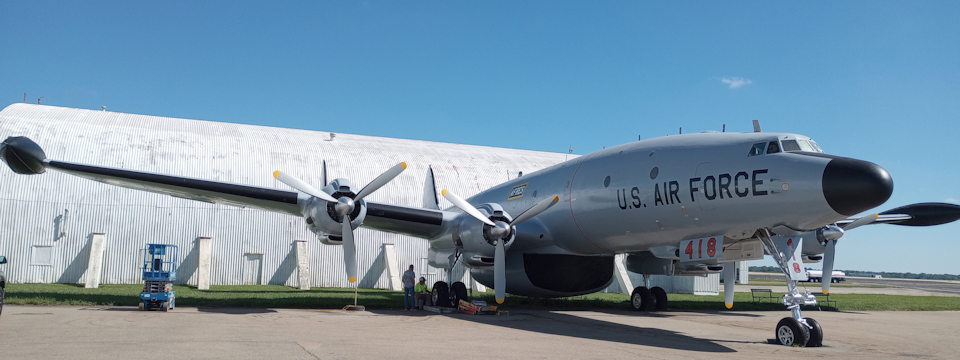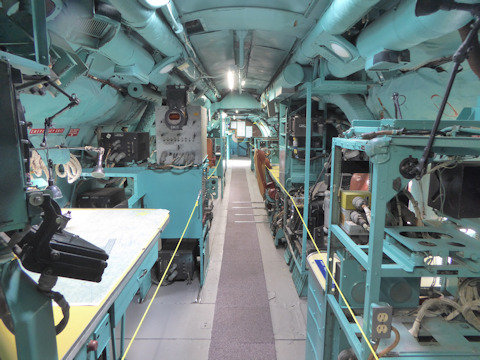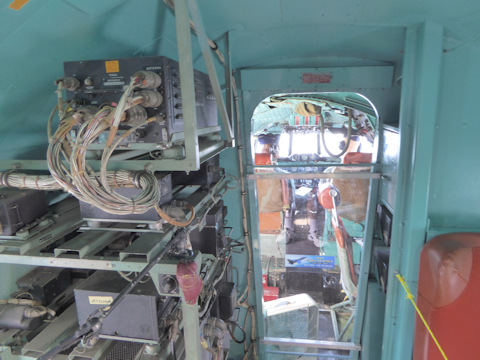In the Vietnam War EC-121s of the 552nd Airborne Early Warning and
Control Wing operated as part of the Big Eye Task Force and later,
College Eye Task Force. The EC-121s monitored and reported North Vietnamese
air traffic, guided U.S. fighters to intercepts, directed aircraft
to their aerial refueling tankers and guided rescue aircraft and helicopters
to downed pilots.
Lockheed
Aircraft manufactured the Museum’s EC-121T in Burbank,
California in 1954 as a RC-121D. It was delivered to the USAF in October
of that year and remained in service for 22 years. It was re-designated
EC-121D in 1962 and modified to an EC-121T in 1968. The modification
included removal of the height finding radar and its “shark fin” radome
from the top of the fuselage. All indictors, navigation equipment,
and radios were changed to become a high-speed automated system.
During the latter part of the Vietnam War, EC-121Ts were used extensively.
Two missions per day were common. 418 flew missions over the Plain
of Jars (Laos) and the Gulf of Tonkin about 50 miles from Haiphong
Harbor, North Vietnam. From latter 1973 to early 1974, 418 flew
missions over Cambodia, providing radar control to cargo aircraft
delivering
food to the besieged city of Phnom Penh before it fell to communist
forces. Missions were also flown in the Yellow Sea between Korea
and
China. The aircraft was based at Kwang Ju, Korea and Fukuoka, Japan
during these missions.
During
its service, 418’s
parent units received the Air Force Outstanding Unit Ribbon with
two oak leaf clusters, which are painted
on the right side of the fuselage. The large bulge on the bottom of
the aircraft is the radome for the AN/APS-95 air search radar that
had a range of 250 miles. A number
of blade antennas stick out from the fuselage for various electronic
purposes.
The
Museum received transfer documents from the Kansas State Agency from
Federal Surplus Property in February 1981 for Conditional Transfer
of 418. It was flown to the Forbes Field by Frank Lang from Davis-Monthan
in May
1981.
Assignments:
October 1954 Delivered to 4701st Airborne Early Warning and Control
Squadron, Air Defense Command (ADC),
McClellan Air Force Base (AFB), (Sacramento) California as RC-121D 52-3418
December 1954 8th Air Defense Division, ADC, McClellan AFB
March 1955 551st Airborne Early Warning and Control Wing, ADC, Otis AFB, (Falmouth)
Massachusetts
1962 Re-designated EC-121D
March 1963 966th Airborne Early Warning and Control Squadron, ADC, McCoy AFB,
(Orlando) Florida
1968 Delivered to LTV ElectroSystems, Greenville, Texas for conversion
from EC-121D to EC-121T
August 1969 Assigned to 552nd Airborne Early Warning and Control Wing,
ADC, McClellan AFB, deployed to Taiwan Air Base (AB), Taiwan; Kwangju
AB, Korea; and Korat Royal Thai Air Force Base, Thailand
June 1974 delivered to 79th Airborne Early Warning and Control Squadron,
US Air Force Reserve, Homestead AFB, (Homestead) Florida
April 1976 Retired to Military Aircraft Storage and Disposition Center,
Davis-Monthan AFB, (Tucson) Arizona for storage
August 1980 Dropped from USAF inventory as surplus
May 1981 Ferried to Topeka, Combat Air Museum with Cpt. Frank Lang in
command - final registration - N4257U
This aircraft is on Conditional Transfer to Combat Air Museum from
the Kansas State Agency for Federal Surplus Property
and the General
Services Administration






